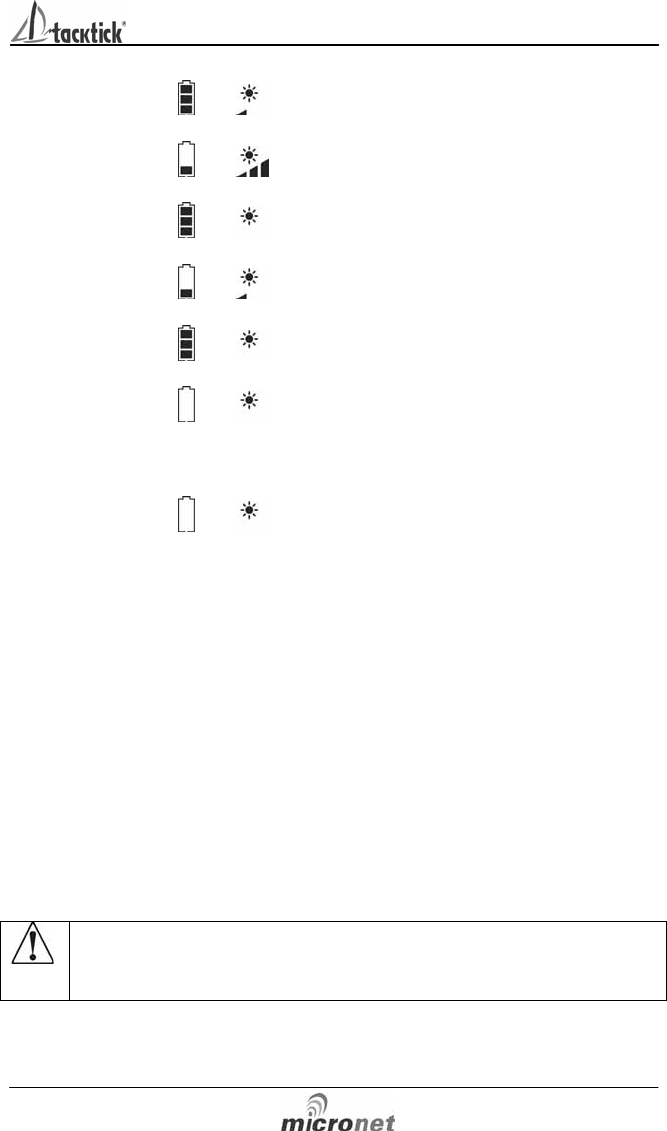
mn100 Dual Digital Display
34
6 Maintenance and Fault Finding
6.1 Care and Maintenance
All Micronet products are totally sealed against water and are not
serviceable. Any attempt to take a Micronet product apart will
invalidate the warranty.
To clean, use only a damp, soft cloth. No detergents, solvents or
abrasives should be used. To avoid damaging a Micronet display unit
we recommend storing in the supplied soft pack when not in use.
If the instruments are to be stored for a long period of time before
next use (Over Winter) ensure that the batteries are fully charged
before storage. If necessary connect to a 9 to 24v power supply for
24 hrs prior to storage.
6.2 Fault Finding and Technical Support
6.2.1 Power Save Alarm sounds.
There has been no significant data activity on the network. The alarm
sounds to indicate that the instrument system will turn itself off. To
continue using the system press any button to cancel the alarm.
6.2.2 Lost Network Alarm sounds.
On a single instrument this indicates that the particular instrument has
lost communication with the Master*. Either there is a problem with the
Master* instrument or the instrument in question has been moved out
of effective range.
On several instruments this indicates that these instruments have lost
communication with the Master*. Either there is a problem with the
master or the Master* has been moved out of effective range. The
instruments will power down shortly after sounding the alarm to save
power.
6.2.3 A single instrument flashes the battery symbol and then
switches off.
The battery level is low on the particular instrument affected. Connect
to a 9 to 24V power source or leave in bright sunlight for 12 hours
minimum to recharge the instrument’s internal battery. If the particular
instrument is the system Master* then the other instruments will sound
the Lost Network Alarm. To continue using the rest of the system
power down and restart the system from another instrument.
Introduction
3
and
Battery is charged and being
topped up by the sun. *
Bright Sunny
Day
and
Battery is low and being charged
by the sun.
and
Battery is charged and requires no
further charging.
Overcast Day
and
Battery is low but maintaining it’s
level.
and
Battery is charged but is not
charging.
Night
and
Battery is low with no charging.
LOW Power
and
Flashing
It is recommended that the
instrument be left in daylight for
some time for the battery to
recover, or charge from an
external 9 - 24V power source. A
fully discharged battery will re-
charge in approximately 12 hours
of direct bright sunlight.
If using the instruments at night power usage can be reduced
dramatically by switching the Backlighting to level 1 or Off. If
Backlighting is not required on instruments located below decks it is
best to set them to “Local” Backlighting control (see page 26 -s31) so
that power is not being wasted in instruments which may not be
visible from the one being viewed.
* If the internal battery is fully charged then it does not matter
how much the instrument is subjected to bright sunlight no further
charging is required and the Charge Rate Indicator will remain low.
If the instruments are to be stored for a long period of time before
next use (Over Winter) ensure that the batteries are fully charged
before storage. If necessary connect to a 9 to 24v power supply for
24 hrs prior to storage.


















